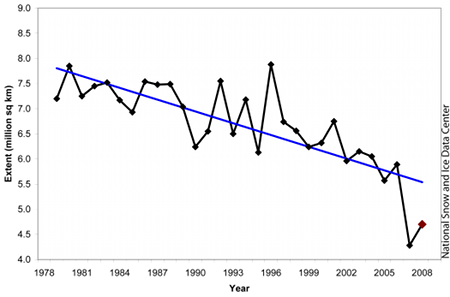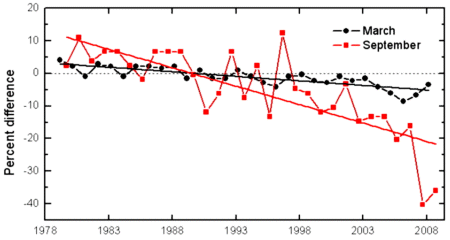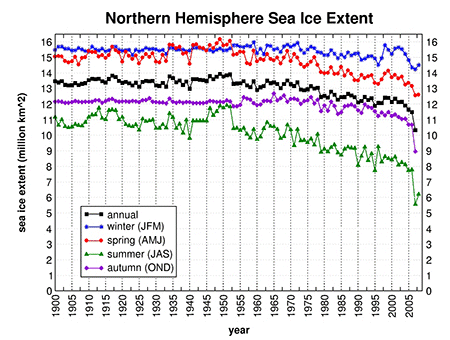5. Ice in the Arctic
Time series - Arctic sea ice extent (1/3)
Changes in the amount of sea ice in the arctic may be changes in
- total extent
- total volume
- thickness
- type or age of ice
- concentration
- geographical area covered
We are going to look at a couple of these - total extent (area) covered and the geographical area covered.
Total ice extent - over thirty years
September minimum
Thirty years of data, for total sea ice extent, in September, are shown in the graph opposite. The sea ice is at a minimum in September after the summer melt. This plot is based on satellite data, so we have data for the geographical variation in ice extent as well.
The rate of sea ice decline in September, calculated using a least squares fit is -11.7 percent per decade.
March maximum
It is also interesting to look at the sea ice maximum in March at the end of winter ice growth. The second graph on the right shows the difference in ice extent compared with a thirty-year mean for both March and September.
Best fit?
When you look at the March points and line opposite, you can see that a straight line through the points is actually quite close to each point.
This is not the case for the September values, particularly in later years.
Do you think that the value of 11% tells the whole story? What values would you get if you only took the last ten years of data?
See the exercise in Chapter 7 of time series to find out!Over 100 years
We don't have satellite data for sea ice extent prior to the late 1970s, but ship and aircraft observations collected by several countries bordering on the Arctic have been used to construct maps of the lateral sea ice extent since the beginning of the 20th century. The last plot on the right below shows time series of the areas enclosed by the ice boundary (defined as having 10% or less of the surface of the ocean covered by ice).What does this time series tell us?
During the first half-century, ice extent in all seasons remained essentially constant. Beginning about mid-century, the summer minimum extent began to shrink while the winter maximum remained unchanged. Starting in about 1975, the maximum, too, began to shrink.
Is the ice melting everywhere?
The graphs on this page show that ice cover in the Arctic has declined over the past thirty years. But they also show that there is quite a bit of change from year to year.
What they can't show is whether ice is decreasing everywhere or increasing in some areas at the same time as decreasing in others.
On the next page we'll look at how satellite data can help with this problem by giving us a view of the geographical area covered by ice.

Source: National Snow and Ice Data Center

Based on a least squares linear regression, the rate of decrease for the March and September ice extents was –2.8% and –11.1% per decade, respectively.
Source: National Snow and Ice Data Center

